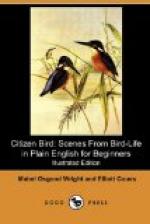The Olive-backed Thrush
Length about seven inches—the same as the Hermit.
Upper parts an even olive color all over.
Under parts cream-yellowish, whiter on the belly, the throat and breast spotted with black.
A yellowish eye-ring, like the creamy color of the breast.
A Summer Citizen of the mountains of the northern United States.
A Tree Trapper and Ground Gleaner.
CHAPTER X
PEEPERS AND CREEPERS
THE GOLDEN-CROWNED KINGLET
“We have been looking at some of the larger song birds; now try the sharpness of your eyes by finding a tiny little fellow—a veritable midget, who belongs to the guild of Tree Trappers. He is usually intent upon his work, continually hopping and peeping among little branches and twigs, and thinks it would be time wasted if he stayed still long enough to give you a chance to look at him. He is so small that there are very few North American birds to compare with him in littleness. The Hummingbird, is smaller still, and the Winter Wren measures no more, only he is chunkier. But what of that? This Kinglet is as hardy and vigorous as the biggest Hawk or Owl. His body is padded with a thick feather overcoat that enables him to stay all winter, if he chooses, in all but the most northern States.
[Illustration: Golden-crowned Kinglet.]
“Small as he is, however, every one knows him, for he disports himself at some time of the year in the North, South, East, and West. If you see a tiny bird, darting quick as a mouse in and out among the budded twigs of fruit trees in early spring, now and then showing a black stripe and a little gleam of red or yellow on its head, it is this Kinglet. If you see such a pygmy again in autumn, exploring the bare twigs, it is this Kinglet. When light snow is first powdering the spruces and bending the delicate hemlock branches, dusky shapes flit out of the green cover. Are they dry leaves blown about by the gust? No, leaves do not climb about in the face of the wind, or pry and peep into every cone crevice, crying ‘twe-zee, twe-zee, twe-zee!’ They are not leaves, but a flock of Kinglets forcing the bark crevices to yield them a breakfast of the insects which had put themselves comfortably to bed for the winter. Think of the work that these birds do, who not only fight the insect army in summer, but in sleet and snow are as busy as ever destroying the eggs that would turn in another season to worms and eat the orchards!
“Though the Golden-crowned Kinglets rove about in flocks a great part of the year, they are extremely private in the nesting season. They go to northern and high places to hide their homes, putting them as far out of reach as does the Baltimore Oriole. This nest is made of moss and seems very large when compared with the size of the builder. It is partly hung from the concealing bough of an evergreen, sometimes quite near the ground, sometimes swinging far up out of sight.” “Does this Kinglet lay two little white eggs, like the Hummingbird?” asked Nat.




